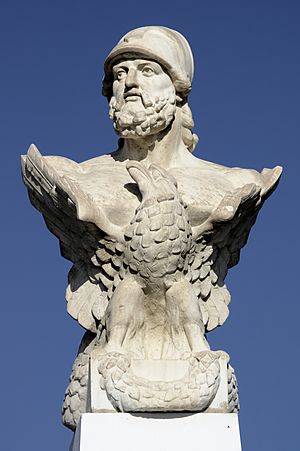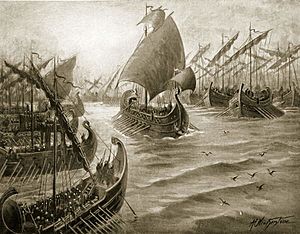Cimon facts for kids
Quick facts for kids
Kimon
|
|
|---|---|

|
|
| Born | c. 510 Athens |
| Died | 450 BC (aged c. 59–60) Citium, Cyprus |
| Allegiance | Athens |
| Rank | Strategos (general) |
| Battles/wars | Persian Wars and Wars of the Delian League:
|
Cimon (born around 510 BC – died 450 BC) was an important Athenian general and politician. He was the son of Miltiades, another famous Athenian general.
Cimon became well-known for his bravery in the naval Battle of Salamis in 480 BC, during the Second Persian invasion of Greece. After this, he was chosen as one of Athens' ten generals to keep fighting the Persian Empire. He played a key role in forming the Delian League in 478 BC, which was an alliance of Greek city-states against Persia. Cimon led the League's early battles, including the Siege of Eion in 476 BC.
In 466 BC, Cimon led a force to Asia Minor and completely defeated a Persian fleet and army at the Battle of the Eurymedon river. From 465 to 463 BC, he stopped the Thasian rebellion, when the island of Thasos tried to leave the Delian League. This event showed how the Delian League was changing into the Athenian Empire.
Cimon became more and more important in Athenian politics. He usually supported the noble families and was against the popular group that wanted to expand Athenian democracy. Cimon also admired Sparta and acted as its representative in Athens. In 462 BC, he convinced the Athenian Assembly to send military help to Sparta, where enslaved people were rebelling (the Third Messenian War). Cimon personally led 4,000 soldiers to Sparta. However, the Spartans refused their help, telling the Athenians to go home. This was a big insult and ruined Cimon's popularity in Athens. He was sent into exile for ten years in 461 BC.
The First Peloponnesian War between Athens and Sparta began the next year. After his exile ended, Cimon returned to Athens in 451 BC. He quickly helped negotiate a peace agreement with Sparta, though it didn't last forever. He then suggested an expedition to Cyprus, which was rebelling against the Persians. Cimon was put in charge of 200 warships. He began to attack the town of Kition, but he died around the time the attack failed in 450 BC.
Contents
Life of Cimon
Early Years
Cimon was born into a noble Athenian family around 510 BC. His grandfather, Cimon Coalemos, was famous for winning three Olympic victories with his chariot team. Cimon's father was the well-known Athenian general Miltiades. His mother was Hegesipyle, whose father was a king from Thrace.
When Cimon was young, his father was fined a large sum of money by the Athenian state. Because Miltiades could not pay, he was put in jail and died there in 489 BC. Cimon inherited this debt. To help his family, Cimon's sister Elpinice married the wealthy Callias, which helped settle the family's debts.
In his youth, Cimon was known for being a bit wild and very direct. Some people said he was more like a Spartan than an Athenian in his straightforward way.
Family Life
Cimon later married Isodice, who was from the important Alcmaeonidae family. They had twin sons named Lacedaemonius and Eleus. Lacedaemonius later became an Athenian commander. Their third son was Thessalus, who became a politician.
Military Achievements
Cimon showed great courage during the Battle of Salamis. He was also part of a group sent to Sparta in 479 BC.
Between 478 BC and 476 BC, many Greek cities near the Aegean Sea did not want to be controlled by Persia again. They offered to join Athens through Aristides at Delos. There, they formed the Delian League, an alliance against Persia. Cimon was chosen as their main commander. As a general, Cimon led most of the League's actions until 463 BC. During this time, he and Aristides helped drive the Spartans out of Byzantium.
Cimon also captured Eion from the Persian general Boges. Other coastal cities surrendered to him after Eion. He also conquered Scyros and removed the pirates who lived there. When he returned, he brought what were believed to be the bones of the mythical hero Theseus back to Athens. To celebrate this, three statues were put up around Athens.
Battle of the Eurymedon
Around 466 BC, Cimon took the war against Persia into Asia Minor. He won a major victory against the Persians at the Battle of the Eurymedon river. Cimon's forces on land and sea captured the Persian camp and destroyed or captured their entire fleet of 200 warships. He also started an Athenian settlement nearby called Amphipolis with 10,000 settlers. Many new allies then joined the Delian League, like the trading city of Phaselis.
Some historians believe that Cimon may have negotiated a peace agreement between the League and the Persians after his victory at Eurymedon. This might explain why the Peace of Callias, negotiated later, is sometimes called the Peace of Cimon. Cimon served Athens very well during the Persian Wars.
Thracian Campaigns
After his successes in Asia Minor, Cimon went to the Thracian colony of Chersonesus. There, he brought the local tribes under control and ended the rebellion of the Thasians between 465 BC and 463 BC. Thasos had rebelled from the Delian League because of a trade rivalry and a dispute over a gold mine. Athens, led by Cimon, attacked Thasos after the Athenian fleet defeated the Thasos fleet.
Facing Accusations
Despite his successes, Cimon faced accusations of taking gifts from Alexander I of Macedon. During his trial, Cimon said he had never been an Athenian messenger to rich kingdoms. Instead, he was proud to deal with the Spartans, whose simple way of life he admired. He argued this showed he did not want personal wealth, but rather wanted to make Athens rich through victories. In the end, Cimon was found not guilty.
Helping Sparta
Cimon was Sparta's representative in Athens, and he strongly believed that Athens and Sparta should work together. He was so fond of Sparta that he named one of his sons Lacedaemonius, which is another name for a Spartan. In 462 BC, Cimon asked the citizens of Athens to help Sparta. Even though some argued that Sparta was Athens' rival and should be left alone, Cimon's idea won. Cimon then led 4,000 soldiers to help the Spartan nobles deal with a big revolt by their enslaved people. However, this trip ended in embarrassment for Cimon and Athens. The Spartans, fearing the Athenians might side with the enslaved people, sent the force back home.
Exile from Athens
This insulting rejection caused Cimon's popularity in Athens to disappear. As a result, he was voted out of Athens for ten years, starting in 461 BC. A reformer named Ephialtes then took the lead in running Athens. With the help of Pericles, Ephialtes reduced the power of the Athenian Council, which was a stronghold of the noble families.
Power was given more to the citizens, including the Council of Five Hundred, the Assembly, and the law courts. Some of Cimon's policies were changed, including his pro-Spartan views and his attempts at peace with Persia. Many pieces of broken pottery used for voting in exile, called ostraka, have Cimon's name on them.
In 458 BC, Cimon tried to return to Athens to help fight Sparta, but he was not allowed.
Return to Athens
Eventually, around 451 BC, Cimon returned to Athens. Although he did not regain his former power, he was able to negotiate a five-year peace agreement with the Spartans for Athens. Later, when a Persian fleet moved against a rebellious Cyprus, Cimon suggested an expedition to fight the Persians. He gained Pericles' support and sailed to Cyprus with 200 warships of the Delian League. From there, he sent 60 ships to Egypt to help an Egyptian revolt. Cimon used the remaining ships to help the uprising of the Greek city-states in Cyprus.
Rebuilding Athens
From his many military successes and money gained through the Delian League, Cimon paid for many building projects in Athens. These projects were greatly needed to rebuild the city after the Persian destruction of Athens. He ordered the expansion of the Acropolis and the walls around Athens. He also oversaw the building of public roads, public gardens, and many government buildings.
Death in Cyprus
Cimon attacked the Persian stronghold of Citium on the southwest coast of Cyprus in 450 BC. He died during or soon after this failed attempt. However, his death was kept secret from the Athenian army. They later won an important victory over the Persians under his 'command' at the Battle of Salamis-in-Cyprus. Cimon was later buried in Athens, where a monument was built in his memory.
Cimon's Importance
During his time of great popularity and influence in Athens, Cimon's domestic policies were not very democratic, and they eventually failed. His lasting success came from his military achievements and his foreign policy. This policy was based on two main ideas: continuing to fight against Persian attacks, and believing that Athens should be the strongest sea power in Greece, while Sparta should be the strongest land power. The first idea helped ensure that direct Persian military attacks against Greece mostly ended. The second idea likely delayed the start of the Peloponnesian War for a significant time.
See also
 In Spanish: Cimón de Atenas para niños
In Spanish: Cimón de Atenas para niños
- Long Walls
- Battle of Salamis in Cyprus (450 BC)
Images for kids



